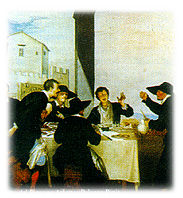
Vincenzo Micheli: Monumental Arch
Russian Orthodox Church, Via Leone X-Viale Milton (bus 1, 8, 19), Michele Preobragensky 1899-1903. Although it reflects the decorative eclectism of contemporary Russian architecture it was actually carried out by Florentine architects and artists; a collaboration that testifies to the cosmopolitan nature of Florence at the beginning of the century.
Magazzini Pola & Todescan, Via Brunelleschi-Via del Campidoglio-Via dei Pecori, Giovanni Paciarelli, 1903. The monumental porticoes blend in perfectly with nearby Piazza della Repubblica, in spite of the modern design of the floral ceramic friezes and the plastic decorations.
House-Gallery, Borgo Ognissanti 26, Giovanni Michelazzi 1911. With this dynamic facade, the most brilliant exponent of Florentine Arte Nouveau architecture manages to give a graceful aspect to a small house constructed in the narrow space between other pre-existant buildings.
Railway Station of Santa Maria Novella, Piazza dell'Unità Italiana, Giovanni Michelucci and others 1932-1934. Here rationalist architecture proposes new ways of respecting tradition. The horizontal design and use of traditional materials help it harmonize with the vertical lines of the mediaeval church.

Giovanni Michelucci: S. Maria Novella Railway Station
Palazzina Reale, Piazza Adua (on the right of the Station of S.M. Novella), G. Michelucci 1934-1935. Built to accomodate the King and other illustrious guests, the design of little palace had to respect the monumental character of official architecture of the time, though this is compensated by an extremely elegant use of materials and fine ornamentation.
Building for housing and shops, Via Guicciardini-Via dello Sprone, Giovanni Michelucci 1954-1957. Traditional materials are also used for this building (faced in stone), its design characterized by the carefully divided proportions of the facades; it is the best designed building among those constructed to replace the houses demolished by the retreating German army.
Hall of the Maestà in the Uffizi, G. Michelucci - C. Scarpa- I. Gardella 1956. The use of open truss beams in the ceiling reminds us of mediaeval churches. A perfect synthesis of beauty and functionality (note the protective railings around the art works, the wooden support holding up Giotto's Maestà, the slits in the walls for moving the paintings).
Aci main offices and hotel, Viale Amendola 36 (bus 8,19), E. Brizzi - D. Cardini - G. Gori - R. Raspolini 1958-1960. Powerful re-enforced concrete columns support the five floors designed for the hotel, while the two lower floors "hang" below: one of the most important rationalist buildings to be carried out in the 1950's.
Leasing Centre (previously Olivetti offices), Via Santa Caterina d'Alessandria 30-34 (bus 1, 8, 19, 20), A. Galardi 1968-1970. Another example of modern architecture characterized by novel static solutions: two towers (that also serve for the stairs) hold up the flat roof that simply rests on top of them and to which the rest of the building is attached.
Building for housing, shops and offices, Piazza San Iacopino (bus 22, 23), M. Dezzi Bardeschi 1970-1972. This caused a great deal of controversy for its irregular shape. Cylinders and prisms are used to create an exterior structure with a succession of dynamic curves and sharp angles further accentuated by the red-brown and pistachio green walls.
State Archives, Viale Giovine Italia-viale Amendola (bus 8, 19), F.Bonaiuti - I. Gamberini - R. Vernuccio 1978-1986. Two main longitudial blocks divide the triangular space of the building: the stepped facade on the exterior, overlooking Viale Amendola, and the wall of glass giving onto Viale Giovine Italia, are linked together by the great Study Hall on the corner.
City bus terminal, Via Valfonda (righthand side of the Station of Santa Maria Novella), C. Toraldo di Francia 1987-1990. The 1980's in Florence are marked by introduction of the softer and more delicate lines of the post-modern period; concrete and steel are abandoned for forms inspired by lively designs. Everything evolves, except for the outcry it stirred up in the city.
